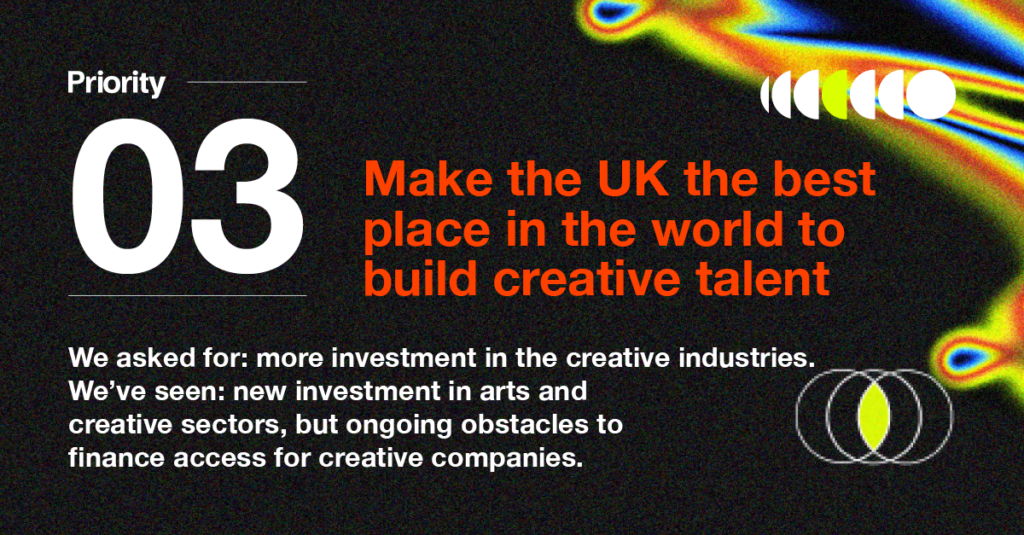
In this series, we reflect on the one-year anniversary of Creative UK’s Manifesto for change. ‘Our Creative Future’ was published just months before the UK General Election that would bring about a new Labour Government.
So much has happened in that time, but one thing has remained constant: Creative UK has been using its voice to shout loudly about the issues we laid out as priority – and those which matter to our members, our partners, the businesses we work with and invest in, and the sector.
So what, if anything has moved on in the last year? This week, we’ll be posting about each priority area from our Manifesto in turn, taking a deep dive into what we said, why it matters, and what has happened so far.
Today we’re focusing on Investment.
We said: “Make the UK the best place in the world to build and retain creative talent and their businesses. Return the arts share of National Lottery funds to 25% and create and maintain genuinely competitive fiscal reliefs and incentives”

The decline in public funding, and the issues around how we invest in infrastructure, are having a serious impact on the cultural sector. Many museums, festivals, galleries, theatres, venues, arts centres and more are fighting for survival.
As a starting point, funding for the arts via the National Lottery should be restored to the original 25% share, to negate the 5% cut in 2011.
Publicly funded arts and culture are a crucible of innovation and drive commercial growth. An ambitious and resilient approach to sustainable finance is needed, to attract greater private and philanthropic investment.
To stimulate this, we propose establishing a Creativity Bank. This would be a wholesale facility offering access to money, knowledge, tools and resources from a range of partners, including UK Government, private capital, regional and local authorities and sector experts. Its creation would incentivise new partnerships and create real long-term growth.
Fiscal conditions should remain competitive to ensure we attract and retain talent. To this end, sector tax reliefs must be genuinely competitive, IR35 should be scrapped, and VAT removed from cultural experiences.
We also need robust data which gives insight into levels of available funding and its sources, going into and across the Cultural and Creative Industries. This will help to better direct public investment, and to attract more private and philanthropic investment in turn.
Key developments:
The government has announced a £60million Creative Industries Growth package – with £16.3million for the Create Growth Programme and boosts to video game start-ups, music venues and film exports. The British Business Bank has been tasked with increasing its support for creative firms to help bridge financing gaps – in a move that aligns with our manifesto call for a ‘Creativity Bank’.
A one-year funding boost features an £85 million Creative Foundations Fund (for urgent repairs to cultural venues) and a £20 million Museum Renewal Fund to help regional museums keep their doors open .
£25 million was allocated to the North East to remediate the Crown Works Studios site in Sunderland – a project expected to create around 8000 jobs and anchor a major film & TV production facility in the region. Culture Secretary Lisa Nandy said this will make Sunderland ‘one of the centres of our TV and film industry for years to come’.
Yet, structural barriers persist. Creative UK’s and the Creative Policy and Evidence Centre’s landmark Unleashing Creativity report (March, 2025) found that creative businesses are over four times more likely than the average firm to cite accessing finance as a growth obstacle. This isn’t surprising given that 93% of creative industry organisations are micro-businesses (fewer than 10 employees) . Many lack tangible assets and rely on intellectual property, which traditional lenders often deem too risky. In response, industry leaders are calling for tailored financial products and innovative investment models.
Creative UK has proposed a new Creative Economy Capital – essentially a public-private investment framework through which government provides guarantees or first-loss capital to de-risk private investment in creative enterprises . Adopting such a model, akin to our envisioned Creativity Bank, would attract the larger scale of private and philanthropic investment needed to help creative entrepreneurs grow. The opportunity is clear: with creative industries outpacing overall economic growth , closing the finance gap could unlock even greater prosperity across the UK’s creative economy.
So how do creatives feel?
Our members, PEC said: XXXX
Related stories
